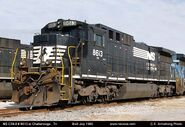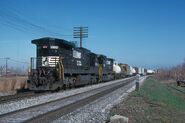Bio[]
The GE (General Electric) C39-8 (C39-S7, Dash 8-39C, or simply "Dash 8") is a type of six-axle, 3,900hp diesel locomotive built from 1984 to 1987 with a total of 161 (including a coal-powered prototype) built.
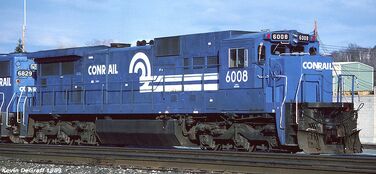
A typical Conrail C39-8 in the 1990's. CR 6000-6021 were the only units built and delivered to the road in 1986; a year shy of the C40-8's debut.
Conrail (CR) and Norfolk Southern (NS) were the only two railroads who originally ordered the model, while later owners consist of CSX (having a small fleet of former Conrail units), various leasing companies, and various foreign and shortline railroads or railways such as FCCA.
They were once commonly seen on their respective owners systems, yet have since become exceptionally rare since the units retirement from 2004 to 2005, as well as from 2006 to around 2007-2008. Conrail's fleet of C39-8 units (having only 22) lasted up until the split of the railroad in 1999; when it became absorbed and divided between CSX and Norfolk Southern. CSX acquired 9 of these units, with NS receiving the remaining 13.
Only Norfolk Southern's fleet of C39-8E units still remain on their roster. All which are currently in storage awaiting their next assignment or status.
Several units were even sold to the National Salvage And Service Corporation (NSSX) prior to their auction to the New Hope And Ivyland in 2010. One C39-8E in particular, was sold to NSSX along with the subsequent C39-8 units (including a lone ex-SOU B23-7) as well.
History[]
The C39-8 (originally, yet unofficially designated as the "C39-S7")
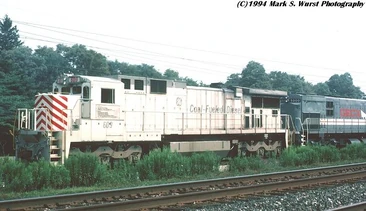
The C39-8 coal-powered prototype, which was also fitted with Dash 7-style trucks (as with other earlier "Super 7" Dash 8 basis or prototype units). The trailing unit; an ALCO Century Series diesel locomotive, actually became one of the basis for the Super 7 rebuild program.
was the first mass-produced model of six-axle diesel locomotive produced by GE since models such as the C30-7 and C36-7 from GE's "Dash 7" line. It was originally a testbed part of the previous "Super 7" project (like its other so-called brethren), which eventually became a rebuild program for older, preceding types or models of high-horsepowered diesel locomotives. Despite having a classic design, it actually supported or featured some of the very first ever high-tech microprocessor technology to be added to a North American freight diesel locomotive. Yet its successor; the C40-8, became even far more advanced and proved to be more popular and successful shortly after the C39-8 ended production. Although the actual locomotive proved to be reliable, it unfortunately wasn't built to last nearly as long compared to their competition: EMD diesels, for most GE locomotive models are often proven to not last nearly as long, but to simply serve their purpose. Hence, being known as "conventional power". Aside from not being a model guaranteed to be a long-lasting power horse, the model proved to not gain much popularity with most railroads other than sparking interests from Norfolk Southern and Conrail for use on their long, heavy-duty coal trains for coal drag service (besides using their 3,200hp counter-parts for ballast and other mineral service).
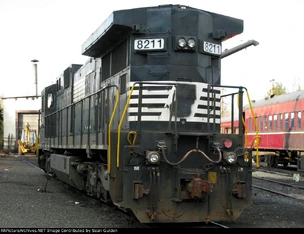
An example of a C39-8's rear hood, being "wedged" differently than other Dash 8 units (similar to the B32-8 and B36-8 experimental units).
Towards the end of production, an "enhanced" model; the C39-8E, was introduced and delivered to Norfolk Southern between March and June of 1987 with a total of 25 units built (NS 8664-8688). Such model was built to C40-8 specifications.
NS received exactly 114 of the original C39-8 units, with another order of 25 improved C39-8E ("Enhanced") units received shortly later (NS 8664-8668). These "Enhanced" units had the distinct wedged or beveled cab design used on the C40-8 (aside from the B39-8 and subsequent models) as opposed to the original "hump-back" or "hunch-back" cab design, and were meant to be an improvement from the original model: having a better cab design, updated dynamic brake grid, and updated trucks, which didn't suffer the same flaws as the original.
The C39-8 lasted on Conrail until 1999 as a result of the Conrail Split by CSX and NS, while CSX utilized their relatively-small fleet of former Conrail units until 2005 when they were sold and scrapped to various leasing, rebuilding, and shortline companies. NS however, retired their original fleets of units from 2005 to 2007, but kept their subsequent C39-8E fleet in storage. It is unknown what fate these units will receive, yet NS has several future plans for rebuilding such units as part of their large rebuilding project which began in late 2011.
All of the original C39-8 units currently remain in service on various shortline, leasing, and rebuilding companies. Most notably NREX and the Pennsylvania Northeastern shortline (subsidiary of the New Hope And Ivyland Railroad). Many have also found their way on the FCCA (Ferrocarril Central Andino) railway in Peru.
Flaws[]
Although a successful type of locomotive, the C39-8 eventually experienced numerous flaws with the prime mover (engine or motor), turbocharger, and the overall cab design later on into its career.
The turbocharger and engine often experienced numerous "teething" issues, to which the engine either failed to function properly (primarily with the alternator and crankshafts), or the turbocharger shut down; and/or in some cases, exploded due to overheating (although the once-flawed cooling system was usually responsible for such issues). Though, once the C40-8 debuted with its revolutionary split-cooling system, GE eventually offered a replacement guarantee with preceeding models by encouraging owners to simply replace existing cooling systems with newer, updated models rather than simply trading-in C39-8's for C40-8's (though, both NS and Conrail later grew interested in ordering the latter after successful demonstrations).
The cab; however, was often disliked by most crews and was considered to be a "nuisance" because of increased engine noise, reduced (or a lack of) insulation, which furthermore resulted in rattling, while it also made the actual cab view from the windows seem much lower to the ground, therefore making rides a bit uncomfortable (like with EMD's GP60M). These issues were eventually resolved when NS and CR began to add special insulators or insulation by raising the hood and rebuilding the front carbody sections of the unit's cabs to make it somewhat more porportionate with the rest of the locomotive (aside from GE eventually developing the C39-8E; an improved or "enhanced" model bearing resemblance to it's successor).
The type or model of locomotive also wasn't very fuel efficient. Therefore, it consumed quite a bit of fuel, furthermore causing pollution and emission issues (the issues were eventually studied and compared years later to have 30% more pollution and fuel consumption than GE's Evolution Series locomotives, which are proven to be fuel efficient and strictly follow the US EPA's "tier 2" policy; thus eliminating past issues that the C39-8 had).
Trivia/Facts[]
GECX #609 (originally GE #607; the C36-8 prototype) was converted to having a coal-sludge-powered engine during an experimentation project from 1992 to 1993 (known as a C39-8CF; the "CF" meaning, "Coal-Fueled"). The project however, was a failure. Thus, the unit was rebuilt to Dash 9 specifications and remained as a test unit designated as a "C39-9"; renumbered as GECX #899.

Several examples of former NS and Conrail C39-8 units as seen on the NHRS (New Hope Railroad System).
GECX #609 was also actually involved during the development of the Dash 9, hence the unit's conversion into a C39-9.
The coal-powered unit also began as an inspiration for GE to avoid using coal-powered engines (due to failures), but rather develop AC-traction technology; for AC-traction technology was in the process of being experimented with by EMD (their arch-rival) during the early-1990's, and was a step ahead of GE.
The C39-8 was also one of the first new diesel locomotive models to be purchased by NS after the merger between the Norfolk And Western and Southern was officially finalized in 1992.
Only two of CSX's C39-8 units were repainted into their YN3 scheme, while the others either received their YN2 scheme, or simple patchwork.
The FCCA (Ferrocarril Central Andino; a railroad or railway in the Latin American region) has a fleet of former Conrail units which still retain their original logos, only with a new paintscheme (each unit's scheme usually varies).
Ironically, the railroad also experimented with converting some of their units into being gas-powered, primarily to reduce fuel consumption and air pollution. Such experiment has since proved to be a success: http://www.rrdc.com/article_07_2006_fcca_dual_fuel_pwr_RGI.pdf
Gallery[]
Sources[]
http://www.rrpicturearchives.net/locolist.aspx?id=NSSX
http://www.amazon.com/Locomotives-Modern-Diesel-Electric-Reference/dp/1554078962
http://www.amazon.com/Modern-Locomotives-Horsepower-Diesels-1966-2000/dp/0785826815
http://trainiax.net/mephotosearchresults.php?p_type=GE%2CC39-8

